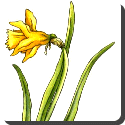 Daffodil — Narcissus is the botanic name for a genus of mainly hardy, mostly spring-flowering, bulbs in the Amaryllis family native to Europe, North Africa, and Asia. There are also several Narcissus species that bloom in the autumn. Though Hortus Third cites 26 wild species, Daffodils for North American Gardens cites between 50 and 100 excluding species variants and wild hybrids. Through taxonomic and genetic research, it is speculated that over time this number will likely continue to be refined. Daffodil is a common English name, sometimes used now for all varieties, and is the chief common name of horticultural prevalence used by the American Daffodil Society. The range of forms in cultivation has been heavily modified and extended, with new variations available from specialists almost every year.
Daffodil — Narcissus is the botanic name for a genus of mainly hardy, mostly spring-flowering, bulbs in the Amaryllis family native to Europe, North Africa, and Asia. There are also several Narcissus species that bloom in the autumn. Though Hortus Third cites 26 wild species, Daffodils for North American Gardens cites between 50 and 100 excluding species variants and wild hybrids. Through taxonomic and genetic research, it is speculated that over time this number will likely continue to be refined. Daffodil is a common English name, sometimes used now for all varieties, and is the chief common name of horticultural prevalence used by the American Daffodil Society. The range of forms in cultivation has been heavily modified and extended, with new variations available from specialists almost every year.
All Narcissus species have a central trumpet-, bowl-, or disc-shaped corona surrounded by a ring of six floral leaves called the perianth which is united into a tube at the forward edge of the ovary. The three outer segments are sepals, and the three inner segments are petals. Though the traditional daffodil of folklore, poetry, and field may have a yellow to golden-yellow color all over, both in the wild species and due to breeding, the perianth and corona may be variously colored. Breeders have developed some daffodils with double, triple, or ambiguously multiple rows and layers of segments, and several wild species also have known double variants.
In Kampo (traditional Japanese medicine), wounds were treated with narcissus root and wheat flour paste, though it does not appear in the modern Kampo herb list. The Roman physician Aulus Cornelius Celsus listed narcissus root in De Medicina among medical herbs, described as emollient, erodent, and “powerful to disperse whatever has collected in any part of the body”. In one scientific study, the ethanol extract of the bulbs was found effective in one mouse model of nociception, para-benzoquinone induced abdominal constriction, but not in another, the hot plate test.
 Kids Portal For Parents India Kids Network
Kids Portal For Parents India Kids Network






